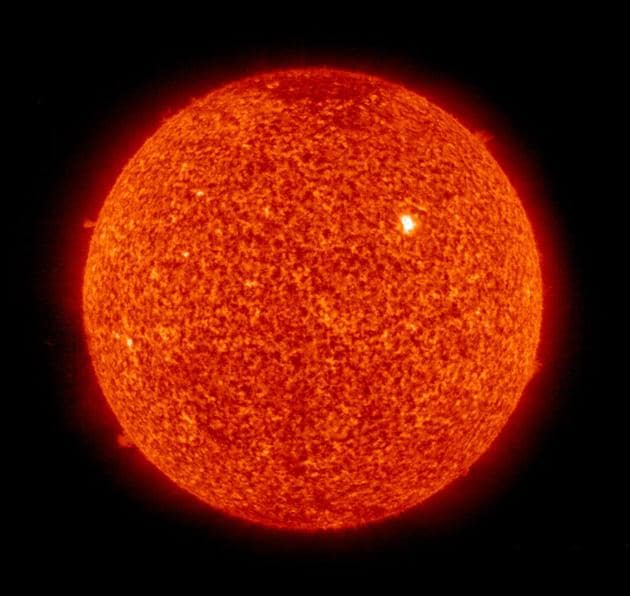TIFR scientists find increase in electric current in sun’s magnetic regions
Findings to help protect satellites based in earth’s outer environment
Scientists at the Tata Institute of Fundamental Research (TIFR) have found that there is an increase in electric current in the sun’s magnetic regions days before a solar flares, a discovery that will help the accurate forecast of solar flares that can affect the earth’s outer environment where satellites are based.

Solar fares are eruptions of high-energy radiation from the sun’s surface and can cause radio and magnetic disturbances on the earth. Forecasting solar flares is important because many modern day technologies, including telecommunication, GPS navigation satellites, electric power grids, air traffic on polar routes, are dependent on space-reliant technologies, and satellite operations are affected and impacted by solar storms.
The study revealed “systematic increase of electric current in magnetic regions from days before flares”, a finding that researchers termed as the most important result which can be useful for advanced machine learning algorithms to develop reliable forecasting system. While previous studies have used machine learning algorithms to improve flare forecasting, researchers said the potential of machine learning for revealing precursors and associated physics of solar flares has been under-exploited. Reason being, the complexities involved in the evolution of the sun’s active regions have been an obstacle to complete understanding of flaring processes and accurate prediction.
“The study is important, exciting and first step in the path of inquiry that tries to use computer science to understand the physics of a particular system rather than merely making predictions. However, we will be able to tell if this will lead to something meaningful only after the line of work matures,” said Dibyendu Nandi, professor and coordinator, Center of Excellence in Space Sciences, Indian Institute of Science Education and Research, Kolkata, who was not involved in the study.
With India sending Aditya-L1 spacecraft next year to study the sun next year, Nandi said there are discussions to send a vector magnetograph in space in the future to measure the magnetic field. “Therefore creating an expertise within India to study magnetic field of the sunspots and how they produce flares will be critical and helpful because India is becoming increasingly dependent on the space environment,” said Nandi, whose expertise lies in studies related to solar magnetic cycle.
Researchers said while their work does not involve predicting flares, the ultimate goal is to provide warnings of solar flares an hour in advance that will help various agencies prepare better for severe space-weather consequences because flares travel at the speed of light. At present, US-based National Oceanic and Atmospheric Administration Space Weather Prediction Center issues warnings on solar flares twice per day for the next 24 hours.
“The agency, however, cannot reliably predict the first solar flare from a magnetic region. That’s because when a magnetic region is not flaring, it continues to not flare for a long time. When it suddenly flares, many flares are subsequently produced,” said Dattaraj Bhalchandra Dhuri, lead author, department of astronomy and astrophysics, TIFR. “As a result, it cannot capture changes from the non-flaring state to flaring state which is very crucial because the evolution of these magnetic regions leads to flare.”
Discrepancy in issuing warnings can also occur as the forecast is subjective – a person studies different satellite images and makes a prediction. To improve flare forecasting, several studies over the last decade have trained machine learning algorithms using the sun’s magnetic-field observations based on data from NASA’s Solar Dynamics Observatory to automate the process of predicting solar flares.
The three-member team trained the machine learning algorithm based on data from NASA’s Solar Dynamics Observatory of magnetic field in magnetic regions of the sun from 2010 to 2013, following which they tested the machine on the data from 2014 to 2016. The machine could predict 91% of the solar flares in the flaring active regions 24 hours in advance. The accuracy was 89% in the non-flaring active regions.
On an average, the results showed more than 60% accuracy for three days before the flares to three days after flares, which implies the magnetic active regions are in a flare-ready state days prior and post solar flares. “By understanding how magnetic regions that produce solar flare are different from those that do not produce them, we want to understand the underlying processes of changes in the magnetic regions that lead to solar flares,” said Dhuri.
The study was published in the Proceedings of the National Academy of Sciences of the United States of America. The study was a collaborative work between TIFR and the Center for Space Science, New York University Abu Dhabi, Lockheed Martin Solar and Astrophysics Laboratory, US, and Hansen Experimental Physics Laboratory at Stanford University.




